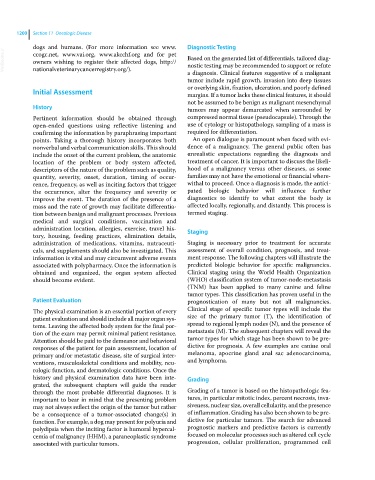Page 1262 - Clinical Small Animal Internal Medicine
P. 1262
1200 Section 11 Oncologic Disease
dogs and humans. (For more information see www. Diagnostic Testing
VetBooks.ir ccogc.net, www.vai.org, www.akcchf.org and for pet Based on the generated list of differentials, tailored diag-
owners wishing to register their affected dogs, http://
nostic testing may be recommended to support or refute
nationalveterinarycancerregistry.org/).
a diagnosis. Clinical features suggestive of a malignant
tumor include rapid growth, invasion into deep tissues
or overlying skin, fixation, ulceration, and poorly defined
Initial Assessment margins. If a tumor lacks these clinical features, it should
not be assumed to be benign as malignant mesenchymal
History tumors may appear demarcated when surrounded by
Pertinent information should be obtained through compressed normal tissue (pseudocapsule). Through the
open‐ended questions using reflective listening and use of cytology or histopathology, sampling of a mass is
confirming the information by paraphrasing important required for differentiation.
points. Taking a thorough history incorporates both An open dialogue is paramount when faced with evi-
nonverbal and verbal communication skills. This should dence of a malignancy. The general public often has
include the onset of the current problem, the anatomic unrealistic expectations regarding the diagnosis and
location of the problem or body system affected, treatment of cancer. It is important to discuss the likeli-
descriptors of the nature of the problem such as quality, hood of a malignancy versus other diseases, as some
quantity, severity, onset, duration, timing of occur- families may not have the emotional or financial where-
rence, frequency, as well as inciting factors that trigger withal to proceed. Once a diagnosis is made, the antici-
the occurrence, alter the frequency and severity or pated biologic behavior will influence further
improve the event. The duration of the presence of a dia gnostics to identify to what extent the body is
mass and the rate of growth may facilitate differentia- affected locally, regionally, and distantly. This process is
tion between benign and malignant processes. Previous termed staging.
medical and surgical conditions, vaccination and
administration location, allergies, exercise, travel his- Staging
tory, housing, feeding practices, elimination details,
administration of medications, vitamins, nutraceuti- Staging is necessary prior to treatment for accurate
cals, and supplements should also be investigated. This assessment of overall condition, prognosis, and treat-
information is vital and may circumvent adverse events ment response. The following chapters will illustrate the
associated with polypharmacy. Once the information is predicted biologic behavior for specific malignancies.
obtained and organized, the organ system affected Clinical staging using the World Health Organization
should become evident. (WHO) classification system of tumor‐node‐metastasis
(TNM) has been applied to many canine and feline
tumor types. This classification has proven useful in the
Patient Evaluation prognostication of many but not all malignancies.
The physical examination is an essential portion of every Clinical stage of specific tumor types will include the
patient evaluation and should include all major organ sys- size of the primary tumor (T), the identification of
tems. Leaving the affected body system for the final por- spread to regional lymph nodes (N), and the presence of
tion of the exam may permit minimal patient resistance. metastasis (M). The subsequent chapters will reveal the
Attention should be paid to the demeanor and behavioral tumor types for which stage has been shown to be pre-
responses of the patient for pain assessment, location of dictive for prognosis. A few examples are canine oral
primary and/or metastatic disease, site of surgical inter- melanoma, apocrine gland anal sac adenocarcinoma,
ventions, musculoskeletal conditions and mobility, neu- and lymphoma.
rologic function, and dermatologic conditions. Once the
history and physical examination data have been inte- Grading
grated, the subsequent chapters will guide the reader
through the most probable differential diagnoses. It is Grading of a tumor is based on the histopathologic fea-
important to bear in mind that the presenting problem tures, in particular mitotic index, percent necrosis, inva-
may not always reflect the origin of the tumor but rather siveness, nuclear size, overall cellularity, and the presence
be a consequence of a tumor‐associated change(s) in of inflammation. Grading has also been shown to be pre-
function. For example, a dog may present for polyuria and dictive for particular tumors. The search for advanced
polydipsia when the inciting factor is humoral hypercal- prognostic markers and predictive factors is currently
cemia of malignancy (HHM), a paraneoplastic syndrome focused on molecular processes such as altered cell cycle
associated with particular tumors. progression, cellular proliferation, programmed cell

